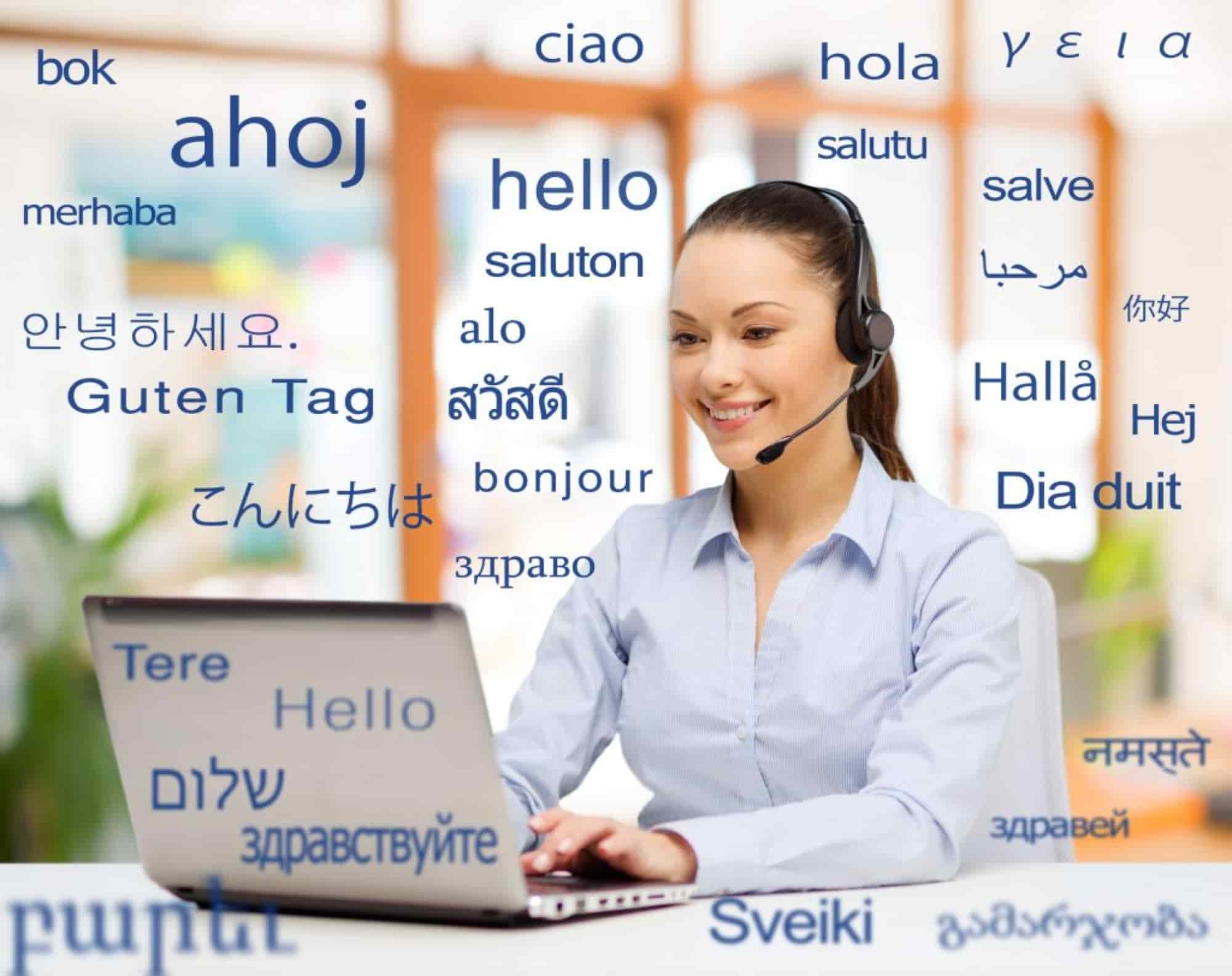
By: Allie
Date: June 11, 2020
Have you heard this term – translation memory (TM) – when shopping for translation services?
You may have an inkling of the concept behind it: a database that offers discounts based on the use of your previously-translated content.
But – did you know: that it’s an essential tool to keep messaging consistent; that it produces faster translation turnarounds overall; and that your TM discounts compound as your database grows?
Understanding the power of your translation memory is the first step to ensuring you soak up ALL the juicy benefits your TM has to offer!
Let’s get into the nitty-gritty of translation memory so you know exactly what to expect and what questions to ask when purchasing translation services.
Let’s start with the basics…
What is translation memory (TM)?
Translation memory is a database that stores translated content for your specific company.
When you request translation, the language services provider (LSP) compares your TM with the new content, searching for matching segments. These matching segments are ones you don’t have to pay full price for!
Basically, it’s a way to save time and money using your already-translated content.
And, the larger your TM database, the more discounts you’re likely to receive.
Faster translation turnaround
This may seem obvious, but the more matching segments that are found in your TM, the less the content translators need to translate, and the less time it takes to deliver the project.
Matching TM segments are pulled into translation software for expert language professionals to review during the translation step. They ensure that the matching segments fit the context of the new document perfectly before applying them to the final translation.
As your TM database grows, the more likely it is there will be matching segments in new translations, and the faster your project turnaround will be.
Translation memory cultivates consistency
Utilizing your TM database also keeps messaging consistent throughout all your material.
For example, content containing scientific or medical terms should be translated the very same way every time to maintain consistency.
If “using the stethoscope” was translated into German in your translation project from 5 months ago, and it comes up again in a new German translation project, it should be translated the same way.
Consistency is good for business, and good for your reputation.
Consumers and clients know what to expect when reading material from your company. Any inconsistent messaging is confusing and will turn-off clients and consumers from using your product or service; it could even appear to be dangerously unprofessional.
Owning your translation memory
Did you know that you own your TM, and can request it at any time from your current LSP?
Owning and having easy access to your TM is a powerful tool when it comes to negotiating project pricing.
When seeking a new or replacement LSP to handle your translation project, you can provide them with the existing TM for your company for the requested language(s) and speak with them about how they apply TM discounts.
Questions to ask about translation memory
Next time you talk to your translation vendor, or when seeking a new vendor, make sure to ask:
- What is your translation memory discount structure?
- Will my company have access to our TM database at any time?
- Tell me about your translation memory database and how it will benefit my organization.
If you already have access to your translation memory database, and are seeking a new vendor, ask:
- What discounts can I expect with my existing translation memory?
If you’ve made it all the way to the end of this blog, great job!
You now know more about what translation memory is, how it benefits your organization, and how to talk to language services providers about it.

By: Allie
Date: May 28, 2020
Have you been tasked with finding translation services for a project at your job – but have no idea where to start?
Or maybe, you’ve been executing translation projects for years, but never completely understood the process. You throw it over the fence, so to speak, and *hope* you get the best price and best quality in return.
Don’t worry – this blog is here to help!
Whether you use translation services on a daily basis or every once in a while, following these tips will maximize your projects’ success while increasing your bottom line.
1. Always take advantage of Translation Memory discounts.
What is Translation Memory?
Translation memory (TM) is an advanced database that stores all your organization’s already-translated content.
When you submit a new translation project, the database runs it against all the TM stored for your company and searches for matching segments of words between them.
“Perfect” to “Fuzzy” matches found by the database are segments you do not pay full price for— which can add up to considerable savings for your organization.
Plus, savings compound over time as you submit more translation projects and build your organization’s unique TM!
Some Language Services Providers (LSPs) use TM databases, some don’t.
Ask your current LSP about your TM database and discounts—or if you’re shopping around—put translation memory discounts on your list of topics to discuss with potential LSPs.
2. Provide original, editable files to save money, and time!
Did you know: if you provide the original, text-editable documents for your project, you will both pay less and save time?
Yes! It’s true… But why?
Because providing NON-editable files, like PDFs, scans, and images requires extra steps in the quoting and delivery process.
Non-editable files must go through a process called Optical Character Recognition (OCR) to pull text out of the file for translation. Unfortunately, this also means losing most of the formatting found in the original documents.
Files then must be recreated with Desktop Publishing (DTP) in order to match the original format of the documents – adding DTP service fees to the quote.
The lesson here: Always provide original, editable files when submitting translation projects.
It is much faster to get a quote, and, you’ll save money by avoiding steep DTP service fees.
3. Know the essential steps that result in quality translation.
Professional, quality translation does not happen in one step – and anyone telling you otherwise is doing you a disservice.
Though the steps in the translation process can vary depending on your needs, there are basic steps that are pretty much universal in the language services industry:
- Document preparation
- Translation
- Linguistic review by AT LEAST 2 translators
- DTP services (document & file formatting)
- Quality assurance check & delivery
- Client review
Knowing, and understanding, the basic steps of translation puts the power in your hands when discussing a project with a new or current LSP.
Don’t hesitate to ask detailed questions about any steps for which you need clarification.
An experienced LSP will be happy to answer your questions in detail and provide recommendations based on your project’s requirements.
4. Cheap translation = cheap quality.
How much quality are you willing to give up when it comes to price?
This is an essential question when it comes to weighing your options among multiple quotes from LSPs.
Though it can be tempting to go with the cheapest option, the quality of your translation will certainly suffer if you do.
Why?
Because of the Scope Triangle (aka Quality Triangle) – a well-known concept in project management illustrating the relationship and trade-offs between the 3 primary forces in a project: Time, Cost, and Quality.
When one force is fixed (usually time), the other 2 forces will vary in inverse proportion to each other.
For a translation project this basically means—if you want cheap translation, you will get cheap quality in return, because it is impossible to produce great quality if the cost is too low.
Now, if quality is not important to you, then by all means, buy cheap!
But for the vast majority of us who value quality results, understand you do get what you pay for.
As you weigh the options between multiple quotes ask the LSPs what their quality assurance process looks like, and again, never hesitate to ask questions to make a better-informed decision.
Have questions?
Don’t hesitate to contact us here at Teneo Linguistics Company.
Click here!

By: Allie
Date: May 13, 2020
The COVID-19 pandemic has affected us all in incredibly different and similar ways.
Abiding by social distancing and quarantine guidelines has become a shared experience—something that brings us together, while we’re apart.
In the spirit of spreading positivity during this trying time in the world, the team at Teneo Linguistics Company wants to share with you what we’re grateful for during this time.
HEATHER, KEY ACCOUNT MANAGER
Taking a moment to take stock of the positive during this categorically negative moment in my lifetime, my overwhelming gratitude is empathy.
Care… support… protect… are words that are increasingly present in the virtual vernacular. Without empathy, “flattening the curve,” “social distancing,” and other buzz words would be just that. Words.
The world has seemingly become more empathetic to cause and effect. More individuals than ever before are taking care in their actions and developing precautions to protect their loved ones and strangers around them. It truly is a beautiful thing.
However, my cats have grown increasingly more apathetic. They can’t wait for me to go back to the office and stop telling them how cute they are.
ALISON, GRAPHIC DESIGNER
As I think about gratitude during this challenging time of pandemic and social distancing, my family immediately comes to mind.
While living 24/7 with two tweens and a husband certainly has its frustrations, I am so impressed with my children’s ability to adapt to online learning, FaceTime chats with friends and family, and learning to compromise and share common spaces.
We’ve enjoyed evening dog-walks together as a family, bike rides, and board games.
Spending this time sheltering in place has emphasized how lucky I am to share my life and my home with fun, warmhearted people … even if I do have to remind them 10 times a day to pick up after themselves!
SONJA, PROJECT MANAGER
COVID-19 has definitely changed our lives. All of us around the globe are living situations totally unthought of only two months back. We’ve naturalized scenes that appear to be out of futuristic movies, but instead of turning off the screen and returning to our beautiful “normal” lives, we suddenly find the track is on “Repeat” over and over, and we are trapped in this unrealistic cycle.
Besides the obvious feelings of chaos, frustration, and sadness, this new scenario has also brought some good things with it.
To me, family union is one of them, going back to the basics, playing forgotten board games, cooking together, looking over old photos, simply chatting. There is a strong, comforting feeling of union, that we are in this together.
On the work side of things, I’ve been the “remote” gal in the team for a while now. My morning meetings went from conversing with the team sitting around a conference table, to all of the team meeting remotely.
We are suddenly all sharing what it means to be remote, the tricks and tips, the insights into what working virtually actually implies. In this sense, the current situation has been very rewarding. We all know the weaknesses but also that it can be done.
There is relief, there is gratitude, there is a different kind of happiness. We are still a team, a united group of people that continues to move forward in spite of it all.
Go team, go TLC!
SHARON, COMPLIANCE OFFICER
The last eight weeks have been an amazing time; I think “surreal” describes it for many of us.
I feel so fortunate that in my little corner of the world, where I’m semi-retired and working mostly from home already, the changes in my day-to-day life have been minimal.
What has changed, for which I am very grateful and somewhat surprised to realize, is that I feel a deeper appreciation of and connection to others. For me, suddenly not being able to get up and go—to spend time with family and friends at will, to browse the bookstore (a favorite pastime) —has been an awakening. An awakening to the Importance of connection and the feeling of belonging.
Joining the morning Zoom meeting with work colleagues I feel so much more the sense of being part of a team, of collaboration; moving our weekly in-person prayer group session to the virtual world has created a cozier space for sharing; and Zooming lunch together with friends after live streaming our Sunday church services has been an unexpectedly fun, and fulfilling experience.
My oldest nephew, literally a rocket scientist, working in the Jet Propulsion Lab in Pasadena, CA, last week invited his parents and younger brother in Austin, TX, uncle and aunt in Seattle, WA, and me (in Crowley, TX) to a Zoom chat that was a source of wonderful re-connection, and a seriously good time! The visual component, seeing everyone “together”, seems to be key to this feeling of connection.
I now realize how much I value this closeness, this sense of belonging, these connections, not just with family, but also friends, acquaintances, and my work family.
Our global village is dealing with a dangerous new virus, and it is a scary time in many ways. It is also a rich opportunity for good to emerge, sometimes in unexpected ways and places. I, myself, feel blessed.
ALLIE, MARKETING MANAGER
Social distancing has given me a different perspective of what’s important in my life, and I am immensely grateful for that.
Like so many others, I had a difficult time adjusting to being apart from friends and family. My pre-pandemic life kept me so busy—I rarely stopped to reflect and appreciate all the blessings in my life.
When social distancing started taking its toll, I knew I needed to find an activity that would foster peace of mind and gratitude in my life.
I started taking daily walks along the beautiful trail near my home and found the peace of mind I was looking for. The trail follows a river teeming with nature that fosters reflection within.
I watch ducklings trailing their mothers across the river’s surface.
I watch egrets navigating carefully through the water before taking off in glorious flight.
I watch sparrows practicing their flight maneuvers over the water, skimming their beaks across the surface for a refreshing sip in between tricks.
Observing and experiencing this abundance of nature clears my mind and allows thoughtful, unhurried self-reflection to flow freely.
I am grateful for all these moments as the world continues to navigate through the chaos of the pandemic. And I look forward to seeing the positive effects of this newfound peace as life gets back to “normal”.
NICK, PROJECT MANAGER
Over the last month or two, the 24-hour news cycle has somehow become even more constant, a cacophony of doom and gloom. And, though we are collectively grappling with such a serious challenge, as we approach two months of stay-at-home, I’m reflecting on how easy it can be to feel “alone in a crowded room” if we don’t foster the right mindset.
Though work has continued “as normal” for many of us in the language services industry, there’s still extra time carved out from what would otherwise be arduous commutes, shopping trips, coffee outings, and the like.
I’m choosing to use the time to be mindful, and I realize how grateful I am, even in the midst of struggle and upheaval.
I’m grateful for the stability that exists in language services and for the ability to work from home with relative ease that is inherent in the industry.
I’m grateful for the quiet, still moments in the morning that allow me to enjoy a leisurely breakfast instead of a bagel scarfed down in the hustle and bustle of a smoggy highway.
I’m lucky enough to be staying at home with family and have the benefit of face-to-face communication so we can more easily reminisce about how much we miss the grocery store.
I’m grateful for the glimmers of hope in the news, as humanity comes together to meet the challenge we face, for the technology that allows us to meet virtually, and for the community we have, even from afar.
Above all, I’m grateful to contribute in some small way and feel I’m making a difference by facilitating communication during a time when timely, accurate information is more important than ever.
And I’m grateful that my company fosters an attitude of gratitude that will help us all to make it to the light at the end of the tunnel with a smile.
HANA, CEO & OWNER
I put so much on my daily gratitude list these days. The fact that we can so easily work from home, that our business has not been affected as much as others and that we continue to be a source of livelihood and stability for our team.
I am grateful for home projects completed, like the Texas windmill my children bought for me and my husband put together. I am grateful for our furry children and the smiles they put on our faces every day.
We have been going through a training program with two of our three dogs and are on track to have very well-behaved canines by the time the pandemic is over!
I am grateful for the food we are growing in our yard. Our peach and pear trees are looking especially good this year and we have more kale than the local grocery store!
I am grateful for the little things. For spending time with my husband. The birds singing in the garden; seeing so many of our neighbors out, working in their yards and exercising. The smell of fresh-baked bread. A good night’s sleep. Sunshine. And I am grateful for the big things, like my family’s health. I am grateful for it all.

By: Allie
Date: May 1, 2020
As a healthcare professional, it is your job to protect patient data from being compromised.
Failure to secure patients’ Protected Health Information (PHI) can damage your reputation, result in hefty HIPAA violation fines, and expose affected patients to identity theft.
But it’s not just the medical organization itself that must comply with HIPAA regulations—ALL business associates of the organization must comply.
So if one of your business associates violates HIPAA—it’s YOUR organization that will be considered responsible.
Your translation services provider is considered a business associate.
Life science and medical translation projects require transferring, uploading, and downloading documents (including ones with PHI) between you, your translation vendor, and their resources.
With all those documents being transferred from one place to another, it begs the question—
Does your translation services provider exercise HIPAA-compliant translation processes?
What is HIPAA – Compliant Translation?
Your translation vendor should treat patient PHI with the same high-security measures and priority as your organization does.
The safe and secure transfer of files/documents for translation is key to HIPAA-compliant translation.
If your translation vendor requests or sends files with PHI through email—this is a HIPAA violation!
If a data breach occurs in your or your vendor’s email client, and documents with PHI were attached to emails—the culprit would have access to your patient’s personal information, which could result in identity fraud.
And according to HIPAA regulations, a breach like that would require you to inform ALL affected patients that their information had been compromised.
You lose patients’ trust, your reputation suffers, and the financial losses would be severe.
Ask your translation vendor…
- Is the translation process HIPAA-compliant?
- Are translators trained in HIPAA-compliant processes?
Many translation services vendors have their own HIPAA-compliant project management portal for your staff to securely upload documents for translation, and to safely download completed files. The same portal is used to grant document access to translators working on your project.
Encrypted file-sharing platforms or FTP clients like Citrix ShareFile can also be used for transferring files securely.
Translators should be trained in proper HIPAA-compliant procedures when handling documents with PHI.
Procedures like:
- Ensuring all files with PHI are deleted from their computer after a project is complete.
- NEVER sending completed translations through email.
- If documents with PHI are accidentally sent by email, then the email must be deleted from the inbox AND from the “Deleted” folder.
Even with all the HIPAA training you and your team go through, slip-ups happen and sometimes a document with a patient’s PHI is sent non-securely through email and other avenues. Again, if this happens, the email should be immediately deleted in all email folder locations.
Let’s go over the basics of PHI and HIPAA compliance.
What is PHI?
PHI stands for Protected Health Information. It is defined as any personally identifiable information used by a HIPAA-covered entity or business associate in relation to healthcare services.
There are 18 identifiers that are included under the HIPAA Privacy Rule:
- Names
- All geographical identifiers smaller than a state, except for the initial three digits of a zip code if, according to the current publicly available data from the U.S. Bureau of the Census: the geographic unit formed by combining all zip codes with the same three initial digits contains more than 20,000 people; and the initial three digits of a zip code for all such geographic units containing 20,000 or fewer people is changed to 000
- Dates (other than year) directly related to an individual, including birth date, admission date, and discharge date.
- Phone Numbers
- Fax numbers
- Email addresses
- Social Security numbers
- Medical record numbers
- Health insurance beneficiary numbers
- Account numbers
- Certificate/license numbers
- Vehicle identifiers including serial numbers and license plate numbers
- Device identifiers and serial numbers
- Web URLs
- Internet Protocol (IP) address numbers
- Biometric identifiers, including finger, retinal and voice prints
- Full face photographic images and any comparable images
- Any other unique identifying number, characteristic, or code (except the unique code assigned by the investigator to code the data)
Any files or documentation with this information MUST be handled properly under the HIPAA Security Rule.
What is the HIPAA Security Rule?
The main goal of the HIPAA Security Rule is to protect patients’ PHI while allowing medical organizations and other HIPAA-covered entities to utilize new technologies to improve the quality and efficiency of patient care. These organizations are required to maintain reasonable administrative, technical, and physical safeguards for protecting PHI.
Here are the General Rules direct from the U.S. Department of Health and Human Services:
- Ensure the confidentiality, integrity, and availability of all PHI they create, receive, maintain, or transmit.
- Identify and protect against reasonably anticipated threats to the security or integrity of the information.
- Protect against reasonably anticipated, impermissible uses or disclosures.
- Ensure compliance by their workforce.
Protecting Patients is Priority
Your organization is passionate about data protection, and your translation services vendor should be too.
If you are unsure if your vendor is HIPAA-compliant, ask them!
If they do not employ stringent HIPAA policies to securely handle your documents that contain PHI… it’s time to find a new vendor.
Helpful Links:
As an experienced language services provider, Teneo Linguistics Company only uses HIPAA-compliant translation processes because we care about protecting the privacy of patients, and care about the success of our clients. Our project management staff and language professionals are trained to protect PHI in all projects, and with exact detail. If your organization is interested in life sciences translation services, please contact us!

By: Allie
Date: April 27, 2020
Are you blessed with a superpowered bilingual brain?
Does your gift of language bring you joy, and a different perspective of the world?
If you feel your polyglot powers bring you extraordinary advantages…YOU ARE RIGHT!
And here are just a few reasons why:
1. Remarkable Cognitive Ability
If you have been bilingual since childhood, chances are you have heightened cognitive skills.
As a child, the process necessary for a bilingual brain to switch from one language to another, and even to determine which language is appropriate for the situation, fosters the development of improved problem-solving abilities and multitasking.
Studies conducted on multilingual preschoolers showed that they were much faster at sorting puzzles, categorizing shapes by form and color, and had an easier transition between tasks than their monolingual peers.
What does this mean for a bilingual adult?
Well, you probably have an easier time focusing on tasks and working through problems in all aspects of your life. Awesome!
2. Exceptional Creativity
Researchers at the University of Mashad studied a population of advanced language learners ages 16-18 and compared their creative thinking ability with their monolingual counterparts.
The study revealed that the bilingual language learners scored higher on the Torrance Test of Creative Thinking, which measures originality, fluency, elaboration, and flexibility.
This is attributed to the bilingual individual’s constant awareness and vigilance in ensuring that the two languages do not interfere with each other in any particular situation.
Learning a second language also exposes one to cultures and customs that are different from one’s own. Having that different perspective provides an incredible creative advantage over monolinguists, who have the perspective of only one language.
3. Impeccable Memory
Do you remember details in a conversation or meeting that others do not? This is not a coincidence.
Studies show bilinguals have higher information retention than those that are only fluent in one language because they have had to memorize vocabulary and grammatical structure for two languages.
Growing up bilingual gives you a head start in memorization skills starting in early childhood, which comes in very handy as a bilingual adult.
So, be grateful for your awesome bilingual superpowers!
They bring you success in brilliant – and often unexpected – ways.

By: Allie
Date: April 14, 2020
As a healthcare professional, what’s your top priority?
Of course, it’s to provide the best care possible to all your patients.
That should include patients Limited English Proficiency (LEP), right?
And as you know, clear communication between you and your LEP patients is critical in building the best care plan possible.
How do you ensure effortless communication?
US law requires healthcare facilities to offer qualified interpreters to LEP patients, but it can be time-consuming to schedule in-person interpreters for every single appointment.
Plus, it is nearly impossible to schedule an interpreter for last-minute appointments or emergencies.
Moreover, in this time of social distancing, scheduling in-person interpreter services can be risky.
Fortunately, there’s a solution that makes it easy to access qualified medical interpreters on-demand, and without risk:
Over the Phone Interpreting (OPI).
OPI services give you on-demand access to vetted, qualified interpreters in seconds, improving patient care one call at a time.
Here’s how.
1. Provide Better Access to Care
Your patients come to you for a reason: to receive quality care and guidance from you, their chosen healthcare provider.
They trust you to listen to their medical concerns, answer their questions thoroughly, and to provide an effective treatment plan.
With a professional foreign language interpreter on the line, you both can be confident that your messages transmit seamlessly because over the phone interpreters are experienced, vetted, and specialize in medical terminology.
Best of all… nothing gets lost in translation.
It’s simple. If LEP patients can communicate with you, they will have access to better care—your care.
2. Increase Patient Trust
Patients trust you with their lives, their care, and their wellbeing.
Using OPI services allows you to easily connect with LEP patients on a personal level while building trust and rapport.
Talking through a language professional naturally puts both you and your LEP patients at ease because communication is effortless.
With substantial language support, LEP patients are more likely to continue receiving care from you and more likely to recommend friends and family to your practice.
3. Better Communication, Better Treatment
Clear communication with your patients will always result in better treatment.
Without it, your patient cannot inform you of their symptoms, which could lead to a misdiagnosis, health complications, or a possible lawsuit against your organization for not providing adequate language support.
Unfortunately, many patients and healthcare providers think using bilingual persons to interpret during appointments (like family members or bilingual medical personnel) is adequate for communication.
Let’s get one thing straight. Bilingual isn’t enough.
Why? Because professional interpreters are language experts, and bilingual persons are not. It’s that simple.
Take the tragic story of 18-year-old Willie Ramirez, for example.
Willie’s family took him to an emergency room in south Florida after he suddenly fell into a comatose state.
With no family members proficient in English, they brought in a bilingual family friend to help communicate with medical staff about Willie’s condition.
Unfortunately, the friend misinterpreted the Spanish word “intoxicado” (feeling sick from ingesting something) to “intoxicated” in English.
The incorrect translation led to the medical staff wrongfully diagnosing and treating Willie for a drug overdose, instead of the intracerebellar hemorrhage he was actually experiencing.
Willie developed quadriplegia because the medical staff didn’t treat the hemorrhage quickly enough, and he and his family successfully sued the hospital for $71 million.
Don’t take the risk. Use OPI services, so nothing gets lost in translation.
4. HIPAA Compliant
OPI platforms, websites, and portals are HIPAA compliant, and all medical interpreters are HIPAA trained.
All information entered into the OPI platform, and all communication through the over the phone interpreter stays confidential and secure.
And you can breathe easy knowing you and your patient’s information are protected—a win-win.
5. Cost Effective & Easy
OPI platforms take just minutes for initial set up and are easily accessible through a phone, tablet, or computer.
You pay only for the minutes used, with no minimum fees, making it significantly more cost effective than in-person interpreting.
With OPI services, you’ll spend less money and less time scheduling interpreting services – all while improving your patients’ care with ample language support.
Offer OPI services and show LEP patients you care.
They’ll thank you for it.

By: Allie
Date: March 17, 2020
The current coronavirus (COVID-19) outbreak is affecting individuals, communities, businesses, medical facilities, and organizations all over the world in severe and significant ways.
The practice of social distancing as a means of limiting public exposure to the virus, has countless businesses and organizations scrambling to adapt to the precautions, calling for people to avoid mass gatherings. Many organizations are setting up employees to work remotely and quickly trying to assess how the outbreak will affect their processes in various capacities.
Organizations and individuals that rely on interpreting services for medical appointments, business meetings, interviews, consultations, and other activities, must find safer alternatives to in-person interpreting as a social distancing precaution.
Over the Phone Interpreting (OPI)
Over the phone interpreting services (OPI) are a great alternative to in-person interpreting. OPI technology provides vetted, high-quality interpreting professionals quickly, securely, and safely through easy-to-use interpreting platforms. OPI technology has advanced significantly in recent years and offers many benefits to organizations.
Easy & Secure Accessibility
You can request interpreting through most OPI platforms via phone, tablet, or computer – and most are fully compatible with Android and Apple devices.
The platform allows the user to conveniently connect to live interpreting professionals on-demand or to schedule services in advance. State-of-the-art OPI platforms use strong, secure connections to ensure a smooth call, every time.
Many OPI platforms offer video remote interpreting services (VRI), allowing video calls with interpreting professionals. This option is great for virtual conferences, webinars, and specific languages like American Sign Language (ASL).
Also, OPI services are typically more cost-effective than in-person interpreting. Most OPI platforms charge by the minute – which means no fees for mileage and no cancelation fees.
Specialty Domains
New OPI platforms allow you to request interpreting professionals that specialize in a specific domain. This feature ensures you access an interpreter with the qualifications and background needed for your call.
Domains include, but are not limited to:
- Business
- Corporate
- Customer Service
- Education
- Emergency Services
- Events
- Federal Government
- Financial Services
- Legal
- Local Government
- Medical
- Medical (non-certified)
- Non-profit
- Personal
- Social Services
- Sports
- Travel/Hospitality
Stay Safe, Use OPI Services
During this critical time, social distancing is an incredibly vital practice to ensure yourself and others’ safety. Choosing to use OPI services for your interpreting needs promotes social distancing. OPI interpreters work remotely, and the services operate through a device like a phone or a laptop.
If your organization depends on professional interpreting services, make the safe choice, and use over-the-phone interpreting services as an alternative to in-person interpreting.
For more information on over the phone interpreting services, contact Teneo Linguistics Company.
Helpful Links:

By: Allie
Date: March 9, 2020
You are a multinational corporation that uses translation services on a daily basis with an annual volume of translated words that reaches well into the millions.
You have at least two large Language Services Providers who service your high-volume translation needs and are large corporations with a sizable footprint.
Sure, you want to work with more businesses, and perhaps throw a few smaller, minority-owned businesses into the mix to enrich your diversity supplier program.
Or, maybe you’d like to know if your company is maximizing cost savings through leveraging already-translated content or by using AI-powered machine translation.
But… your language services vendors say you better stick with them. Why? Because they “sit” on the largest volume of already-translated content in the form of translation memory databases, and you are, naturally, getting the best deal with them.
In fact, you might hear the pitch from one of your vendors to “centralize your localization program” with a single vendor — them.
Yes, centralizing your localization program offers many valuable benefits to your organization, but their single-vendor pitch has one HUGE flaw.
You do not have to settle for working with one Language Services Provider to achieve your centralization goals.
Centralizing and owning your localization and translation process within your organization CAN be achieved successfully, no matter how many Language Services Providers you work with.
How? To understand that, let us look at the benefits of centralization individually, and how owning your localization process relates to each one.
1. Control Over Your Content/Data
Translation work is subject to copyright. Once you pay your bill, the translated content —and the translation memory database created from it —belongs to you.
At Teneo Linguistics Company, we ask our customers if their translation memories are under their legal and physical control, and 9 times out of 10 the answer is “No”.
In most cases, it is the language vendor who is in control of the data, and therefore, in control of:
- How savings are calculated
- How your translation memory databases are maintained and managed
- Who has access to your data
The argument for centralizing with only one vendor does not hold here because you would give total control of your very valuable, company-specific memory into the hands of another company, instead of diversifying your risk.
2. One Technology
Different language vendors use different technology, workflows, glossaries, and terminological databases to process your translation and localization projects.
The process of migrating multiple vendors under one technology may seem like a deterrent to centralizing, but there are incredible benefits to gaining control and owning the process.
If you centralize with a single vendor, you lose control over:
- What technology is used
- Its effectiveness for your organization
- Modifying the technology to be compliant to company standards
- All security considerations
Take control of your language process by making an informed decision about which centralized technology and which processes work best for your company’s needs.
Seek professional translation and localization consulting services to aid in finding the best-fit solution for your company. They will also assess your current localization program with you and make recommendations on how to reach your localization goals.
3. Financial Savings
Consolidating all your translation memory databases from all your language services vendors into one location gives you better leverage for negotiating volume discounts and cost savings for repetitive content.
But this only works well under two conditions:
- If you have full access to all your data and the process of how fees are calculated.
- If the translation memory is maintained and curated effectively, and/or if the AI-powered machine translation engines are properly trained and retrained.
If these two conditions are not met, you will still be at the mercy of your vendor’s pricing with no negotiating leverage.
Experienced localization and translation consulting services offer solutions for maintaining and curating your translation memory databases to gain maximum cost savings.
4. Effectiveness
If multiple users within your organization need access to submit translation projects, it can be a real headache when working with multiple vendors. Each one has a different process, a different portal to sign into, different workflows, and separate technology to learn.
This is where implementing centralization, and more importantly, simplification, makes sense.
In a single vendor scenario, you do not have control over how workflows are created or what processes are followed.
In a multi-vendor scenario, centralizing all your language vendors under one technology gives you COMPLETE control over customizing and creating workflows that work best for specific translation projects.
For example: Vendor-A offers dramatically lower rates for translation while Vendor-B offers lower rates for review. To maximize cost savings, you decide you want to set up a workflow that always sends documents to Vendor-A for translation, and Vendor-B for review. With a centralized solution, you can!
It is much more efficient to be able to create that workflow in one centralized location that contains your complete translation memory databases—than to try and set it up in separate portals with separate translation memory databases.
5. Evaluating Performance
Every organization strives to accomplish important goals and KPIs including reducing cycle time, achieving financial savings, or working on continuous improvement. But how do you improve these KPIs in regard to the workflow of your organization’s chosen Language Services Providers?
With no direct insight into your vendors processes, it is difficult to evaluate how they are performing—whether you have one supplier or multiple.
Ask yourself:
- Do you have access to reporting on how well suppliers are achieving deadlines across all projects?
- Do you know what the total volume savings is with each supplier and how it changes over time?
- Do you know how nonconformances are handled?
This is critical information that every organization should have easy access to when evaluating vendor performance and when determining how to improve their KPIs.
What we have here is really not a case of using multiple vendors vs. just one. This centralization scenario is more about taking control of the process in a meaningful way for you and your organization’s goals.
How Do I Centralize the Process?
So, how do you achieve all of these incredible benefits? Consider centralizing your localization process but instead of centralizing with one supplier:
- Keep all the suppliers you like.
- Take control of the process and your data.
- And keep it under your own roof.
Owning your own Translation Management System (TMS) is a completely realistic solution that allows you to consolidate all your translation memory databases from all your vendors into one secure location.
There is no need to invent or build anything, there are many TMS solutions made specifically for corporations looking to centralize their localization processes.
You can then have have multiple Language Services Providers working and focusing on what they do best – translation. Meanwhile, you are in complete control of maintaining and leveraging your translation memory databases.
More benefits of owning your own TMS include:
- Being legally and financially protected.
- Easy usability with one simple way to upload files and submit translation projects.
- Ability to monitor your project’s progress with complete transparency.
- Detailed reporting that includes supplier performance metrics.
- Automated processes to reduce cycle time and increase cost savings.
The benefits to your organization adopting a centralized localization system are endless!
Wait, you say you have no one on your staff to manage the TMS? No problem! You can hire a consulting service to set the system up and manage it for you, perhaps by embedding their own employee into your company so they would be available to you at all times.
The choices are plentiful and will likely vary from corporation to corporation depending on their specific centralization goals.
Look for centralized solutions that help you achieve your goals, put control and ownership squarely into your hands, and allow you to continuously maintain full compliance.

By: Allie
Date: March 1, 2020
There are countless reasons why an interpreting service is needed. Medical facilities like hospitals and doctors’ offices are required by federal law to provide interpreters for patients who speak limited English. Businesses setting up meetings with potential foreign clients or partners want to make a good impression by hiring a professional to interpret their native language. Law firms work with clients who need an interpreter to go over important case and court details. Contrary to popular belief, face to face interpreting is not ALWAYS necessary for every situation. Over the phone interpreting is a convenient and lower-cost way to meet interpreting needs.
1. Over the phone interpreting platforms offer 100% on the go service
Interpreting service and scheduling technology has grown with the times. Now, interpreting platforms are accessible from a PC, Mac, laptop, smartphone, and tablet. These platforms include features like scheduling over the phone interpreting for any time of day, or immediately reaching a vetted interpreter over the phone for unexpected interpreting needs. If you need an interpreter fast, these platforms are the way to go. Video calling is also available for some languages, like ASL (American Sign Language). Just select the language conversion needed, and call. A vetted, experienced interpreter will answer the line, and provide peace of mind that the desired message is communicated accurately.
2. Over the phone interpreting costs LESS
Hiring a face to face interpreter is necessary in some situations, but it is also costly. There is usually an industry standard 2 hour minimum for services, and sometimes a fee for mileage. An interpreting platform does not have a minimum fee or time frame for over the phone interpretation. The platform tracks the call time and charges by the minute. So, if interpreting is only needed for 45 minutes, then ONLY 45 minutes are charged. No minimum fee, PERIOD. How easy is that? Choosing to save money & time with an easy access over the phone interpreter is a smart choice, and a no brainer.
3. A live interpreter is ALWAYS better than machine translation
Free online translation is a tempting option because, well, it’s free. Unfortunately, when it comes to free, you get what you pay for. Translation robots do not understand the cultural and contextual nuances of every language. Only a living, breathing human being with cultural knowledge of the language can provide that. Using a cheap service will put companies, medical offices, law firms, and other businesses at risk for a lawsuit or a tarnished reputation. Do NOT risk mistranslation with a robot. Use a professional, vetted, and experienced over the phone interpreter to make sure accurate messages are communicated with no mistakes.

By: Allie
Date: December 20, 2019
Partnering with language service providers that use translation memory technology is a smart choice whether you are a business, law firm, educational organization, medical facility, or any other type of organization.
Here at Teneo Linguistics Company, we understand that the use of translation memory (TM) technology can be hard to grasp. In this article, we will answer the questions – how does TM work? And how does it benefit your organization?
How Does Translation Memory (TM) Work?
Translation memory turns your existing translated material into existing or new translation memory and recycles content to save you more.
Let’s say you are a company who needs an employee handbook translated into Spanish, and you bring it to us to provide high quality translation. We securely upload the documents to our TM database where the original content AND translated content is stored as the translator works on your project. This creates a “memory” that we can run against other documents you need translated in the future.
Then the next year, when you need the updated version of the employee handbook translated, the database runs the document against all the TM stored for your company. It searches for matching segments of words and pulls in the previous translation and how well it matches the previous version. Perfect to fuzzy matches that the database finds are segments you do not have to pay full price for and can mean CONSIDERABLE SAVINGS.
In this employee handbook example, your company would ONLY pay full price for translation of new updated material to the handbook since the TM would match most of the content.
How Does Translation Memory Benefit Me?
Consistency
One benefit of building TM with your original and translated content is the consistency of terms used in your material. If a phrase is translated one way on a marketing brochure, the same phrase will be translated the same way on any other content we translate for you.
This keeps brand messaging, product descriptions, user guides, HR documents, websites, and any other content consistent & accurate throughout all translated content for your company.
Speed
The more of a match the TM is to your document, the less content our language professionals need to translate. This makes our turnaround times much faster for returning clients who have a bank of TM. We save you time by getting your projects back faster, and TM saves us time by finding higher matches the more you do business with us.
Savings
As stated before, utilizing TM will bring you considerable savings. The more translation projects we complete for you, the higher match percentage our TM database will calculate as you bring us new projects.
You can add “savings over time” as a KPI to measure how your partnership with Teneo Linguistics Company saves your organization money.
Still have questions about translation memory? We’re happy to help.
Send us a message HERE.











